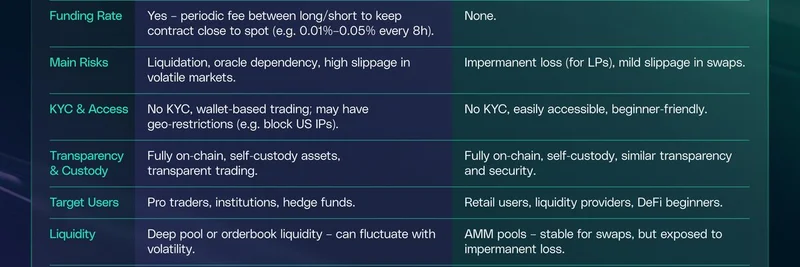If you're diving into the world of decentralized exchanges on Solana, especially for trading those wild meme tokens, you've probably come across terms like Perp DEX and Spot DEX. But what's the real difference? A recent tweet from Solana Daily breaks it down in a handy infographic, highlighting how these two types of DEXes operate differently. Let's unpack it in simple terms so you can level up your trading game.
Core Products and
- Let's refine the title to "Perp DEX vs Spot DEX: Key Differences Explained for Solana Traders" to better target crypto enthusiasts.
Mechanisms
At its heart, a Perp DEX (short for Perpetual Decentralized Exchange) lets you trade perpetual futures. These are contracts that allow you to go long or short on an asset with leverage, and they never expire—unlike traditional futures. Think of it as betting on price movements without owning the actual token. The mechanics often rely on models like vAMM (virtual Automated Market Maker) or order books, with platforms like Jupiter Perps or Drift leading the charge on Solana.
On the flip side, Spot DEX is all about straightforward token swaps at a 1:1 ratio, no leverage involved. It's built on the classic AMM (Automated Market Maker) model, similar to Uniswap, where you provide liquidity to pools and earn fees. Popular Solana examples include Raydium, Orca, and PancakeSwap. This is where most meme token launches happen, with quick buys and sells driving the hype.
Leverage and Funding Rates
One of the biggest draws of Perp DEX is leverage—up to 10x to 150x, depending on the platform. This means you can amplify your gains (or losses) without putting up the full amount. But it comes with funding rates: periodic fees paid between long and short positions to keep the contract price aligned with the spot price. For instance, rates might range from 0.01% to 0.05% every 8 hours.
Spot DEX? Zero leverage. You're trading at a flat 1:1 rate, which keeps things simple but limits your profit potential compared to perps. No funding rates here, either—it's all about direct swaps.
Risks and Accessibility
Trading on Perp DEX isn't for the faint-hearted. Main risks include liquidation (if your position goes against you), oracle dependency (relying on price feeds that could fail), and high slippage in volatile markets. Plus, there's no KYC required—just connect your wallet—but geo-restrictions or blocked US IPs might apply on some platforms.
Spot DEX feels more beginner-friendly. Risks are milder, like impermanent loss for liquidity providers (LPs) or slippage during big swaps. Accessibility is a breeze: no KYC, easy wallet connections, and it's perfect for retail users dipping into DeFi or providing liquidity for meme tokens.
Both are fully on-chain, ensuring transparency and self-custody of your assets. You control your keys, and trades are secured by the blockchain.
Target Users and Liquidity
Perp DEX appeals to pro traders, institutions, and hedge funds who thrive on deep pool or orderbook liquidity. It can fluctuate wildly, leading to potential volatility, but that's part of the high-stakes game.
Spot DEX targets retail users, liquidity providers, and DeFi newbies. Liquidity comes from AMM pools, which are generally stable for swaps but can suffer from impermanent loss if prices swing.
Trading Fees and Examples
Fees on Perp DEX are low—around 0.02% to 0.1%—with possible maker rebates to encourage liquidity. Top Solana perps include Hyperliquid, Jupiter Perps, Drift, dYdX, and more.
Spot DEX fees hover around 0.3%, distributed to LPs. Well-known ones on Solana are Uniswap, Raydium, Orca, and PancakeSwap.
Pros and Cons
Perp DEX pros: Flexible derivatives trading, high leverage, and full on-chain transparency. Cons: High risk, complex interfaces, and dependency on oracles.
Spot DEX pros: Simple and transparent, ideal for beginners and LPs. Cons: No leverage means lower profit potential.
In the meme token space on Solana, Spot DEXes like Raydium are go-tos for launching and trading new tokens, while Perp DEXes let you leverage positions on volatile memes for bigger plays. Whether you're swapping for the latest pump or hedging with perps, understanding these differences can sharpen your strategy. Keep an eye on Solana's ecosystem—it's evolving fast!


